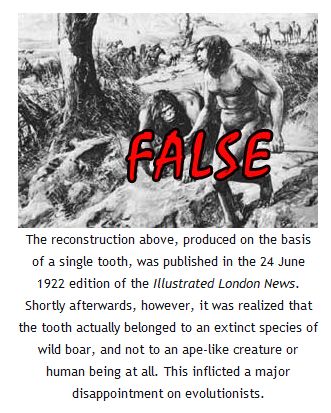In 1922, Henry Fairfield Osborn, director of the American Museum of Natural History, announced that near Snake Valley in Nebraska, he had found a molar tooth that bore common human and ape features, dating back to the Pliocene Period. Before long, a profound scientific debate on the subject had begun. Some people regarded this tooth as belonging to Pithecanthropus erectus, while others said it was closer to being fully human. This fossil was given the popular name of Nebraska Man and the scientific name of: Hesperopithecus haroldcookii.
Based on this single tooth, Nebraska Man's skull and body were reconstructed in artists' conceptions. Pictures were even published of Nebraska Man in his natural habitat, together with his wife and children. This whole scenario was spun out from a single tooth. Evolutionists so believed in this hominid made from whole cloth that when a researcher by the name of William Bryan cast doubt upon all these firmly held opinions based on a single tooth, he attracted the most terrible fury.
However, other parts of the skeleton were discovered in 1927. In the light of these remains, this tooth was found to belong neither to an ape nor to a human being, but to an extinct species of American wild boar known as prosthennops. Science magazine covered the story under the title "Hesperopithecus Apparently Not an Ape Nor a Man." 73
As a result, all pictures of Hesperopithecus haroldcookii were swiftly removed from the literature.
73.W. K. Gregory, "Hesperopithecus Apparently Not An Ape Nor A Man," Science, Vol. 66, p. 579.

No comments:
Post a Comment